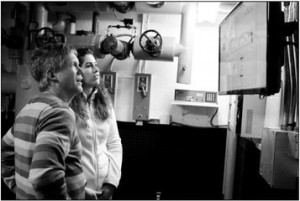Solar Water Heating in Waukesha!
The following article is a reprint from the Waukesha Freeman 12/11/2012, Page A06. Thanks to Steve Edlund!
Students at STEM’s Saratoga campus to learn about energy, heating systems
By Josh Perttunen / Freeman Staff
WAUKESHA – The mechanical room at the STEM Academy Saratoga Campus is proof that there are learning opportunities everywhere.
A location in the building that most people walked by without a second thought was harboring some pretty interesting scientific processes the whole time, said teachers at the school.
Renovations to the room have transformed it into a thermal energy laboratory with three systems on display; a water tank heated by solar energy, a gas-powered hot water heater, and a steam-powered heating system.
To get the most out of the laboratory, educators are the first ones who must learn what is happening there.
What occurs in the room is this: City water flows into cold water tank, where it is heated using the energy gathered by 10-by-12 solar panels on the roof. At times, the solar energy is enough to warm the water to the desired temperature. At other times, such as on cloudy days, the solar energy only warms it to a point and the gas-powered hot water heater heats it the rest of the way.
Either way, said school board member Steve Edlund, who donated some of the labor required to transform the mechanical room into a learning lab, the process serves as a lesson on what solar energy can do.
Seventh-grade science and literacy teacher Brian Brookins said the facility meshes well with the energy unit in the science curriculum.
“We are learning about potential and kinetic energy, the transfer and transformation of energy and energy conservation,” he said.
At the end of the unit, each student performs a mock energy audit of a building.
“The buildings can be anywhere in the country,” Brookins said. “They have to determine what’s best given the circumstances and economic concerns. What is the 20-year payoff for a solar-powered heater in Wisconsin, for example? What about in Arizona?”
After some preliminary lessons offered on Saturday mornings, Brookins isn’t the only educator who is eager to build lessons around what is occurring.
“The room has been transformed from a hodgepodge of old, yucky stuff (such as rusty pipes) into a fantastic opportunity for kids to learn visual literacy in a science area,” said eighth-grade literacy teacher Beth Wartzenluft.
Opening the room to students and seeing what captures their imagination is key.
“Instead of every student having to learn about every part of the system, a student can learn about what interests them and present it to the class,” Wartzenluft said. “Some kids might be fired up by the solar panel, for example. Others might want to learn more about the levels of energy and what is being conserved.”
Lessons that incorporate the mechanical room should begin next semester.
Email: jperttunen@conleynet.com

Charles Auer / Freeman Staff
Teachers Brian Brookins, left, and Tina Koch look at a display Monday showing part of the heating and cooling system at the Waukesha STEM Academy Saratoga Campus. The boiler room will be used for educational purposes.

hmm. This is very interesting. I am trying to figure out about this new solar heating, and what all intels. I have found a lot of useful tips and information on here. Im actually looking to expand my company to offer solar heating solutions. Keep the good good information coming!
Thanks for all your help and expertise Dr. Ben!
For those who aren’t so sure about Solar Thermal in a cold climate, I share this.
We were hit with a Wisconsin winter storm the last few days and couldn’t make any hot water without sun. But this morning the sun came out and I was curios to see what was happening with our system at Saratoga.
I saw the panels from the ground were snow cover…all except the top foot and I knew the panel sensor temperature was getting warm from the morning sun. I went inside the school and checked the controls.
Because our storage tank was depleted and at 60 deg.f we only needed our panel to reach the 18 delta t (78 deg.f). While I was standing there the pump kicked in and sent our solar fluid up to the panels. Before I could get outside, the snow had warmed and slid off the panels. The solar fluid cooled below our turn off mode of 4 deg. f several times before reaching a steady state, but in 3 hours time we were just under 100 degrees f. and still running strong. I went home for a warm bowl of soup and to peck this out.
I’m glad we’re trending the data in graph form. These real life classroom demonstrations and exhibits will make teaching more fun and learning more interesting at Saratoga S.T.E.M.
I’m betting our outstanding educators in the Waukesha School District would agree.